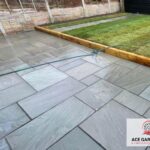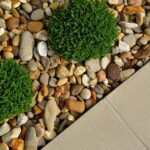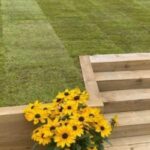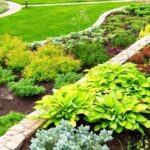Are you bored of the same old customary garden designs? Do you wish to create a landscape that looks beautiful but also follows your values of sustainability and modernity? Well then, you’re in luck! We will explore current trends in landscaping, focusing on modern and eco-friendly styles in the UK.
You might think, ‘But won’t modern and sustainable landscaping need a lot of effort and resources?’ While it is true that these styles might involve some initial investment, they provide long-term advantages that make them worth considering.
From minimalistic garden designs that adopt simplicity and practicality to native plant selections that encourage biodiversity and reduce maintenance needs, there are plenty of inventive options available.
We will investigate water conservation methods such as rainwater harvesting and smart irrigation systems. Additionally, we’ll look into the concept of vertical gardens and green walls as imaginative ways to use up space while adding visual interest.
But that’s not all! We’ll discuss permeable paving and sustainable hardscaping solutions that limit runoff and enable natural groundwater recharge. And if you really want to push the boundaries of innovation, we’ll even touch on incorporating renewable energy into your landscape design.
So join us on this excursion to discover how you can transform your outdoor space into a modern paradise while making a positive effect on the environment. Get ready to welcome modern ideas in landscaping as the future is here, and it’s time to go green!
Minimalist Garden Designs
If you’re aiming to create a sleek and contemporary outdoor space, minimalist garden designs are a great choice. These designs emphasize simplicity and clean lines, creating an atmosphere of peace and sophistication.
Furniture with sleek metal or wooden pieces in neutral tones that blend in with the environment are often used to achieve this aesthetic. The priority is on functionality and minimal decoration.
Water features such as fountains or small reflective pools can give the space a feeling of serenity. Lighting fixtures with simple geometric shapes can create dramatic effects in the night.
When selecting native plants for the garden, it’s important to consider how they will complement the minimalist design without taking away from it.
Native Plant Selection
With a focus on incorporating indigenous flora, the selection of native plants in landscaping designs has become increasingly popular.
Native plant landscaping offers many advantages, making it a cutting-edge choice for those aiming to create wildlife-friendly gardens. By choosing plants that naturally occur in the region, you can foster biodiversity and provide habitats for local wildlife species.
Native plants are adapted to the local climate and require less upkeep compared to exotic species, lessening the need for pesticides and fertilizers. Moreover, these plants have deep root systems that help prevent soil erosion and improve water infiltration. This aids in water conservation and reduces the risk of flooding.
Moving into water conservation techniques, setting up efficient irrigation systems can further reduce water use while sustaining a lush and sustainable landscape design.
Water Conservation Techniques
When it comes to techniques for conserving water, there are several key points to consider.
Rainwater harvesting and storage can be a great way to use natural resources and reduce dependence on conventional sources of water.
Choosing plants that are resistant to drought can help minimize water consumption while still maintaining an attractive landscape.
Implementing intelligent irrigation systems and designing with water efficiency in mind can further advance conservation efforts.
Incorporating these techniques into landscaping practices can contribute to a more sustainable and eco-friendly approach.
Rainwater harvesting and storage
Rainwater harvesting and storage have become increasingly popular in modern landscaping styles, as homeowners search for sustainable solutions for water conservation.
Rain garden design is a creative solution to capture and store rainwater for later use, collecting runoff from roofs, driveways, and other surfaces. This allows the water to infiltrate into the ground slowly rather than being wasted or causing erosion.
These gardens feature specially selected plants that can handle both wet and dry conditions, ensuring that excess rainwater is absorbed efficiently. By employing rainwater harvesting and storage techniques, homeowners can reduce their reliance on traditional water sources while keeping a beautiful outdoor space.
When selecting drought-tolerant plant varieties, it’s important to consider plants that thrive with minimal watering requirements.
Drought-tolerant plant choices
Creating a stunning and water-efficient garden can be achieved by selecting drought-tolerant plants. Drought-resistant landscaping is becoming increasingly popular in the UK, thanks to xeriscaping techniques that reduce the need for irrigation.
Homeowners can create beautiful outdoor spaces while conserving water resources. When choosing plants for a drought-tolerant garden, it’s important to assess their ability to withstand dry conditions. Succulents such as sedum and agave are great choices, with their thick leaves that store moisture. Feather reed grass and blue fescue are also popular options due to their low water requirements and interesting textures.
These plants provide an array of colors and shapes, enabling attractive and eco-friendly landscape designs. Incorporating drought-tolerant plants into your garden will not only lower water consumption but also contribute to the overall sustainability of your outdoor space.
To maximize water usage while maintaining a garden’s beauty and functionality, it’s essential to explore smart irrigation systems and water-efficient design.
Smart irrigation systems and water-efficient design
Maximizing water usage and creating a beautiful garden can be achieved through smart irrigation systems and water-efficient design.
Home automation enables you to remotely manage your garden’s watering schedule, ensuring that your plants receive the right amount of water at the right time.
Soil moisture sensors installed in your garden monitor moisture levels and allow for precise irrigation adjustments based on real-time data. This helps prevent overwatering and conserves water, avoiding unnecessary watering when it’s not needed.
Grouping plants with similar watering needs together and using mulch to retain moisture are water-efficient design techniques that contribute to reducing water wastage.
Vertical gardens and green walls take sustainable landscaping to new heights.
Vertical Gardens and Green Walls
Transform your outdoor space with a stunning vertical garden, bringing nature closer to you while creating an eco-friendly oasis. Designs of living walls and techniques of vertical gardening have grown in popularity in modern landscaping for their innovative and sustainable approach.
These green walls not only offer a touch of elegance to any area, but also provide numerous advantages. They help in bettering air quality by absorbing pollutants and releasing oxygen, working as natural air purifiers. On top of that, vertical gardens maximize limited space, making them perfect for urban environments with limited land.
With progress in irrigation systems, maintenance of these living walls has become easier and more efficient.
Let’s further explore how elements like permeable paving and sustainable hardscaping can enhance your outdoor space while minimizing environmental effect.
Permeable Paving and Sustainable Hardscaping
Sustainable hardscaping and permeable paving are crucial for modern landscaping and can significantly reduce stormwater runoff and flooding. These techniques allow water to penetrate through the surface instead of running off, thus preventing drainage systems from being overwhelmed during heavy rain and lowering the risk of flooding.
Furthermore, these practices help recharge groundwater by allowing rainwater to sink into the ground, which replenishes underground water sources. Additionally, they focus on the use of recycled and eco-friendly materials, making them more sustainable and decreasing their environmental impact.
Reducing stormwater runoff and flooding
While it may seem impossible to completely prevent stormwater runoff and flooding, incorporating sustainable landscaping practices can drastically lessen the effects and protect our communities from destructive consequences.
Green infrastructure, such as rain gardens, bioswales, and permeable pavement, is an important part of managing stormwater by absorbing and filtering it naturally. Through the integration of these features into urban planning, we can create a sturdier landscape that not only reduces flood risks but also increases the overall beauty of our cities.
Rain gardens are planted depressions intended to collect water from rooftops or paved surfaces, enabling it to seep slowly into the soil. Bioswales are vegetated channels that filter stormwater as it passes through them, eliminating pollutants before they reach water bodies. Permeable pavement enables water to penetrate through its surface layer, decreasing runoff and encouraging groundwater recharge easily.
Sustainable landscaping can also aid in refilling underground aquifers by capturing stormwater through techniques like rain barrels or cisterns.
Allowing groundwater recharge
Enhancing the health of our underground water sources can be done by allowing groundwater recharge through sustainable landscaping practices. Groundwater management is critical for preserving the balance of our ecosystem, and rain garden design is an effective way to achieve this.
By adding rain gardens to your landscape, you can capture and store rainwater, allowing it to seep back into the ground instead of becoming runoff. Here are five advantages of rain garden design for groundwater recharge:
- Reduces stormwater runoff and erosion.
- Filters pollutants and contaminants from the water.
- Refills local aquifers and wells.
- Increases biodiversity by providing habitat for native plants and animals.
- Enhances the beauty and aesthetic appeal of your outdoor space.
By applying these sustainable landscaping techniques, we can ensure a healthier future for our groundwater resources.
We move on to the next section on the ‘use of recycled and eco-friendly materials’, exploring innovative approaches to creating a more sustainable landscape.
Use of recycled and eco-friendly materials
Using recycled and eco-friendly materials in landscape design can contribute to a greener and more environmentally conscious approach. Incorporating reclaimed wood, recycled plastic, and crushed concrete into outdoor spaces reduces waste and limits the use of new resources.
Sustainable gardening techniques, such as composting instead of synthetic fertilizers and selecting native plants that require less water and maintenance, further enhance the eco-friendliness of a landscape. These practices promote biodiversity, conserve water, and reduce carbon emissions.
Additionally, opting for sustainable materials adds a distinctive touch to the design, creating a modern and progressive aesthetic. As you move into the next section about incorporating renewable energy, consider how these eco-friendly choices can be combined with solar-powered lighting or wind turbines to create an even more sustainable outdoor space without sacrificing style or functionality.
Incorporating Renewable Energy
When it comes to incorporating renewable energy into your landscaping, there are several important points to consider.
Solar-powered lighting and water features can enhance the aesthetic of your outdoor space and help reduce reliance on traditional energy sources.
Green roofs and solar panels can help maximize the space while making use of the sun’s power for heating and electricity generation.
By utilizing these sustainable practices, you can contribute to a healthier environment and save money on utility bills in the long run.
Solar-powered lighting and water features
Enhance your landscape while reducing your carbon footprint effortlessly with solar-powered lighting and water features.
Solar powered fountains bring a touch of elegance to your outdoor space and run without electricity, making them an environmentally friendly choice. Photovoltaic cells capture sunlight and convert it into energy to power the pump and create a beautiful water display.
LED lights are the preferred choice for energy efficient landscape lighting, as they consume less energy and last longer.
Integrate solar-powered lighting and water features into your landscaping design to form an eco-friendly oasis that shows innovation and sustainability.
To further elevate your outdoor space, consider the incorporation of green roofs and solar panels without compromising on environmental responsibility.
Integration of green roofs and solar panels
Transform your outdoor space, commercial or residential, into a green paradise by integrating green roofs and solar panels to create an environmentally responsible oasis that shows your commitment to sustainability.
Green roofs help reduce stormwater runoff and improve air quality by acting as natural filters. They can also enhance insulation, cutting energy usage for cooling and heating.
Solar panels use the sun’s energy to generate clean electricity, reducing dependence on fossil fuels.
Combining these two elements in your landscaping design maximizes their individual advantages while creating a harmonious and sustainable environment.
Urban spaces, however, pose some challenges for green roofs and solar panels integration due to limited space. Innovative solutions and careful planning can help you overcome these challenges, allowing you to reduce your carbon footprint and energy consumption in a seamless manner.
Reduction of carbon footprint and energy consumption
Create a captivating and conscious outdoor space by minimizing your carbon footprint and decreasing energy consumption with the integration of green roofs and solar panels.
This novel approach to landscaping not only improves the visual appearance of your property but also encourages sustainability. By installing green roofs, you can reduce stormwater runoff, improve air quality, and provide a habitat for nearby wildlife.
Furthermore, solar panels use the power of the sun to create clean energy, reducing your dependence on traditional power sources.
To further lessen your carbon emissions, contemplate participating in carbon offset programs that support renewable energy projects or reforestation efforts. These plans help balance the environmental impact of daily activities like heating and cooling your home or maintaining a lush landscape.
Energy-efficient landscaping techniques, such as strategically planting shade trees, can also contribute to reducing energy consumption. By providing natural cooling during hot summer months, these trees can reduce the need for excessive air conditioning usage.
By embracing these innovative landscaping trends and consciously making choices that prioritize sustainability, you can create an outdoor space that is not only beautiful but also ecologically responsible.
Frequently Asked Questions
What are some common challenges faced when implementing a minimalist garden design?
When implementing a minimalist garden design, challenges can be presented in creating balance and simplicity while still keeping visual attraction. Incorporating native plants can lead to a sustainable and low-maintenance garden that fits the modern style. This can help create an environment that is both aesthetically pleasing and ecologically sound.
How can homeowners encourage the growth of native plants in their gardens?
Want to create a garden that’s full of life? Boost biodiversity by growing native plants. This will attract pollinators such as bees and butterflies, as well as supporting the local environment.
Are there any alternative water conservation techniques aside from rainwater harvesting?
An effective way to conserve water in your garden is through greywater recycling. Reusing water from sources such as sinks and showers can help reduce your reliance on freshwater and promote sustainability.
What maintenance is required for vertical gardens and green walls?
To effectively maintain vertical gardens and green walls, regular watering, pruning, and fertilizing are necessary. These practices can bring numerous benefits, such as improved air quality, reduced noise pollution, and enhanced aesthetic appeal. Incorporating these maintenance requirements into your landscaping endeavors will bring innovation to your project.
Can permeable paving be used in all types of landscapes?
Most landscape gardeners will agree that permeable paving is a great option for sustainable landscapes and offers many benefits. It can reduce water runoff by up to 100%, making it appropriate for driveways, parking lots, and urban gardens. This type of paving can help to improve water quality, reduce flooding, and minimize the need for stormwater management. It also helps to reduce noise pollution and improve air quality. Moreover, permeable paving can help to reduce the urban heat island effect by providing cooler surfaces and increasing green space.












